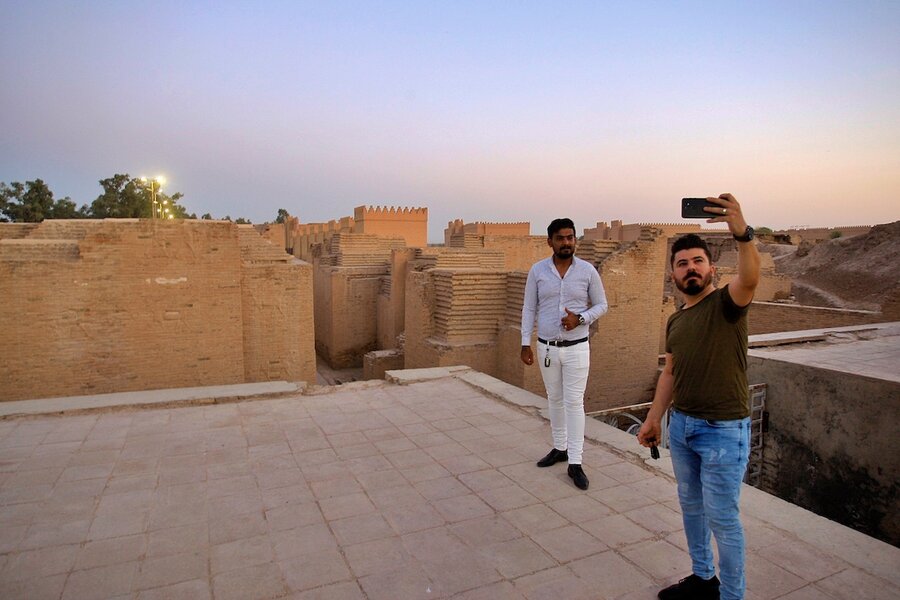Walled defense: Archeologists in Iraq use mudbricks to slow erosion
Loading...
| Ruins of Babylon, Iraq
At the temple of Ninmakh, the Sumerian mother goddess, Iraqi archaeologists are using 7,000-year-old techniques to protect the monument, and the rest of the ancient city of Babylon, from salt seeping into its heart and destroying it from within.
With carefully made desalinated mudbricks, they are repairing the ruins of the UNESCO World Heritage site, which are being corroded by the intrusion of increasingly salty groundwater – a problem linked to prolonged droughts and soil erosion in climate-vulnerable Iraq.
“Salty groundwater is our greatest enemy,” said Ammar al-Taee, an archeologist with the Iraqi State Board of Antiquities who oversees the project and calls himself wryly “the guardian of Babylon.”
The ancient Mesopotamian city on the Euphrates River was once the center of a sprawling empire, renowned for its towers and mudbrick temples. Its hanging gardens, built about 2,600 years ago, were one of the seven ancient wonders of the world.
Problems such as salt intrusion, extreme temperatures, flooding, and soil erosion, linked in part to climate change, are threatening heritage sites in Iraq and around the world, from indigenous rock art in Australia to Bangladesh’s 15th century “Mosque City.”
Mr. Al-Taee and his team learned the painstaking, months-long process of making special low-salt mudbricks from a local artisan who had inherited the age-old technique from his father, and they produced their first batch for repairs this year.
First, the experts scoured the ground for more than a week before finding soil with tolerable salt levels. Even then, the soil had to be “washed” to make it even less salty, Mr. Al-Taee said.
Next, the mud was mixed with sand, grit, straw, and water, shaped into a large circle, and left to ferment for a month, a process that drives the remaining salt to the edge of the mix, producing a white, crystalline fringe.
After scraping away the unwanted salty crust, the remaining sludge was then shaped into bricks, which were laid out on plaited reed mats woven by local women’s cooperatives, giving the blocks a distinctive pattern.
The whole process reduces the amount of salt in new mudbricks by almost three-quarters, Mr. Al-Taee said.
Once they had been stacked in the shade of a tree for a couple of days to air, the bricks were spread out in the sun to bake for a month before being ready for use.
Mr. Al-Taee’s worst enemy, salt, is evident everywhere.
Modern maintenance work on some of Babylon’s monuments used concrete and cement to repair damaged facades and fill cracks, a method he said had exacerbated damage arising from rising salt levels combined with the region’s high humidity.
Another of the projects that Mr. Al-Taee works on involves removing concrete from around the ruins and replacing it with more porous material, such as river stones, another construction technique employed by the area’s residents in past millennia.
“Humidity doesn’t like cement and concrete. It can’t get out of it, so it began going after the weaker places. Of course, mudbrick is weaker, so it started exiting through it,” he said.
That accelerated the erosion of the mudbricks and the numerous engravings that once adorned the walls next to the Ishtar Gate, a colossal structure that towered over Babylon’s main thoroughfare.
An inscription of Marduk, Babylon’s chief deity, still decorates the walls leading to the gate, depicting the god as a hybrid sphinx-like creature with the head of a snake, the front legs of a lion, and a scorpion’s tail.
But below him, an image of Adad, the god of weather, is barely visible – lost to the ravages of time and climate change.
Of the original engraving of a bull, only a hoof can be seen today, and the lower parts of the walls are stained with salty white veins.
Despite the magnitude of the problem, Mr. Al-Taee said he receives no support from the Iraqi government. His current projects depend entirely on foreign funding.
“The lack of support and investment from the government is our biggest challenge,” he said, pointing to the high cost of basic supplies – even clean water, which has become more expensive in drought-plagued Iraq.
The Iraqi government did not immediately respond to a request for comment.
In addition to warding off salt, Babylon’s archaeologists must fight pests that have beset the ruins as the palm trees and vegetation around the ancient city have withered in the parched conditions of recent years.
Mites and wasps that used to feed on the greenery have started to eat away at the mudbrick walls and foundations. Chemical pesticides cannot be used due to the damage they might cause to the ruins, so Mr. Al-Taee has to smoke out the pests instead.
Many of Iraq’s other ancient sites are also feeling the effects of worsening drought.
At the site of the Sumerian city of Girsu, the foundations of the world’s oldest known bridge are being eaten away by salty sandstorms as desert-like conditions spread around the southern city of Basra, where seawater is seeping into the land and destroying fertile soils.
“It’s like a weaponised dust storm – crystals that destroy,” said Jaafar Jotheri, a professor of geoarchaeology at Iraq’s University of Al-Qadisiyah and one of those working on a project to conserve the 4,000-year-old bridge.
Salt is also causing damage at the ruins of Uruk, the first city where writing is known to have been practiced.
“You see cracks wherever you go,” Mr. Jotheri said.
At Babylon, Mr. Al-Taee thinks the country’s ancient past can continue to be mined for solutions to its current difficulties.
“We should be just like the Sumerians,” he said. “If we want to lessen the impact of climate change, then we should be using the right material to combat these changes in nature.”
This story was reported by the Thomson Reuters Foundation.







